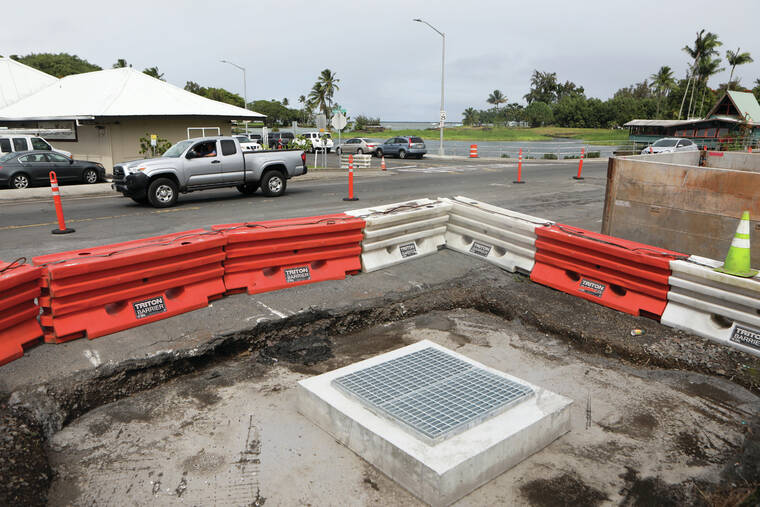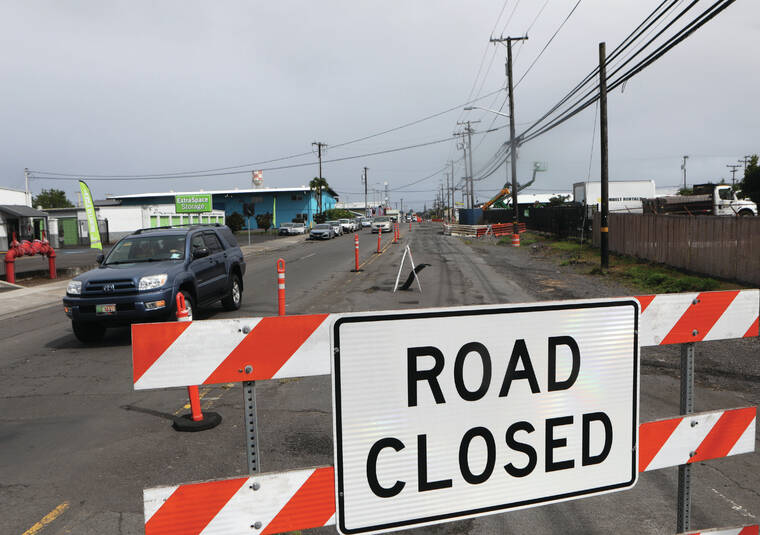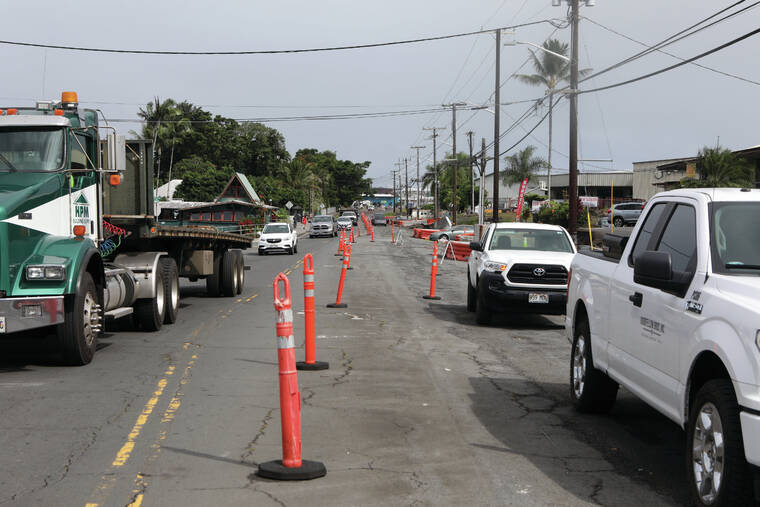The state Department of Transportation confirmed late Friday afternoon that ownership of the portion of Kalanianaole Avenue in Hilo between Kanolelehua Avenue and Kuhio Street is slated for transfer from the county to the state in January.
That stretch of road includes the Kalanianaole Avenue improvement project, which has been plagued by change orders, delays and cost overruns since its start in March 2018. That includes the partial closure of one lane of the the road — the primary access road to the Keaukaha community — with a detour of Keaukaha-bound traffic.
County Councilwoman Sue Lee Loy, whose district includes Keaukaha, told the Tribune-Herald the Keaukaha Community Association was informed Wednesday night of the impending transfer of the road by the county’s Department of Public Works.
“There’s a lot at stake to getting this work done,” Lee Loy said. “I’m genuinely concerned about that. We have an unfinished project. Road ownership is planning to change. And frankly, it’s a broken asset right now.”
Lee Loy said the community association had a lot of questions for DPW staff, adding, “I don’t think they got the answers they wanted.”
On Wednesday, the county announced it terminated the contract with Goodfellow Bros., the construction company hired to widen about a mile of Kalanianaole between Railroad Avenue and Silva Street, including installation of an additional sidewalk and a paved shoulder, turn lane, bicycle lanes, a water line and drainage improvements.
No mention was made in the county’s press release about the transfer of the road scheduled to take place next month, but Cyrus Johnasen, spokesman for Mayor Mitch Roth, confirmed Friday the portion of the road will be transferred. He said, however, the transfer won’t actually occur until the road project is completed.
Ikaika Rodenhurst, the county’s Public Works director, said after a year of negotiating with Goodfellow over a change, “it was clear we were not going to reach an agreement.”
The county decided to throw in the trowel, so to speak, when it couldn’t come to terms with the contractor over a change of paving materials from asphalt to concrete. The change — which increased county estimates of the project’s cost from $18.37 million to $22 million — was necessitated by the presence of Hawaiian Electric fuel lines underground that are vulnerable to the pressure caused by asphalt rollers, the county said.
Hawaiian Electric spokeswoman Kristen Okinaka said the utility relocated poles along the roadway at the county’s request in 2016 and was informed in 2019 of the county’s plan to repave the roadway “and possibly affect our pipeline.” She said notification was through the Hawaii One Call Center’s mandatory Call Before You Dig program.
“We have been working with the county since then, and in September 2020 developed a solution that meets the federal regulations for an underground pipeline,” Okinaka said. “We will continue to work with the county and other utilities on implementing that solution.
The county’s website still lists a February 2022 completion date for the road project, but the county earlier this year pushed that projection outward to August 2022. And now, the finish line will likely be stretched even farther into the future.
Rodenhurst said the county will have “to rebid the remaining work.”
Sherise Kana‘e-Kane, DPW’s information and education specialist, said that to date, $7.06 million has been paid for the project. She said the county has withheld 5% on progress payments to Goodfellow. According to Kana‘e-Kane, new bids will be solicited in January, with the new contract expected to begin by April 1.
“DPW will immediately engage a new contractor to assume management of barriers, markings, and general roadway maintenance to ensure the public’s safety in the construction zone,” she said. “Additionally, DPW is preparing a bid package to engage a contractor to complete remaining tasks for the project, which include additional drainage work, water line relocation, concrete paving of main roadway, and asphalt paving of shoulders.”
Not surprisingly, there is frustration among members of the Keaukaha community — many of whom live on Hawaiian Home Lands.
That community has, over the years, dealt with noise from Hilo International Airport, is a neighbor to the Port of Hilo and surrounding light industry, and been subjected to wastewater issues. That includes an Oct. 18 discharge into Puhi Bay of two million gallons of treated effluent that hadn’t received its final chemical disinfection.
“I don’t know what the level of frustration is,” said Pat Kahawaiolaa, president of the Keaukaha Community Association. “Frustration is frustration — but this is highly, highly frustrating, not only for me. A lot of people complain about ‘that road,’ but they’re on their way to the beach. When they’re done with the beach, they take ‘that road’ on their way home. But for us, the frustration is getting in and out for work, for shopping, for our daily lives. It has somehow affected our bus service. The new bus administration is saying, ‘Oh, we can’t turn into Keaukaha anymore.’
“But the level of frustration? I don’t know what’s higher than pissed off. Is there anything higher than pissed off?”
Kahawaiolaa said he drove on Hilo’s Kilauea Avenue on Wednesday, and noticed the difference in progress between that paving project and the Kalanianaole project.
“They’re finishing up. Finishing up!” he exclaimed. “They’ve got sidewalks and relocated mailboxes, all of that. And we’re stuck with the same old s—t.”
Johnasen called the project “an absolute priority, not just for the residents and people of Keaukaha, but for the entire east side of Hawaii Island.”
“We inherited a lot of the issues with the roadway and the project, but that’s no excuse,” Johnasen said. “We want to make sure that it’s done in an efficient and timely manner — but in a way that’s going to last, and be a good roadway for the community for a long time.”
Johnasen also addressed the “profound and rightful sense of inequity” felt by the largely Native Hawaiian Keaukaha community and all residents of East Hawaii “who regularly frequent the sorely antiquated and dilapidated Kalanianaole Avenue.”
“We are committed to addressing that perception head-on,” Johnasen said. “Unfortunately, at this point, talk is cheap, and the only way to regain the community’s trust and goodwill is to put our efforts where our mouth is and get this project done — and done well.
“As a Native Hawaiian and former Keaukaha resident, I can only speak to my experience, which has been tarnished by mismanagement, poor communication and ever-changing timelines,” he said. “Our administration understands that, accepts responsibility, and is prepared to do what it takes to make it right on this project and all other projects across our island.
“Our residents deserve it, and we thank them for their understanding and willingness to move forward — together.”
Lee Loy — who’s been critical of the project’s management — said it’s time to find a solution.
“I would love to see everyone involved in the project — the state DOT Highways and Harbors, the utility companies, gas, water, (Hawaiian Electric) and the county — to put together an action plan that they could present to the community in the next 10 to 15 days, because the community deserves to know.”
Email John Burnett at jburnett@hawaiitribune-herald.com.











